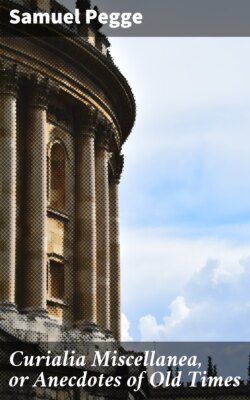Читать книгу Curialia Miscellanea, or Anecdotes of Old Times - Samuel Pegge - Страница 6
На сайте Литреса книга снята с продажи.
1. Whittington Church.
ОглавлениеTable of Contents
The annexed View was taken in 1789, by the ingenious Mr. Jacob Schnebbelie; and the following concise account of it was communicated in 1793, by the then worthy and venerable Rector.
"Whittington, of whose Church the annexed Plate contains a Drawing by the late Mr. Schnebbelie, is a small parish of about 14 or 15 hundred acres, distant from the church and old market-place of Chesterfield about two miles and a half. It lies in the road from Chesterfield to Sheffield and Rotherham, whose roads divide there at the well-known inn The Cock and Magpye, commonly called The Revolution House.
The situation is exceedingly pleasant, in a pure and excellent air. It abounds with all kinds of conveniences for the use of the inhabitants, as coal, stone, timber, &c.; besides its proximity to a good market, to take its products.
The Church is now a little Rectory, in the gift of the Dean of Lincoln. At first it was a Chapel of Ease to Chesterfield, a very large manor and parish; of which I will give the following short but convincing proof. The Dean of Lincoln, as I said, is Patron of this Rectory, and yet William Rufus gave no other church in this part of Derbyshire to the church of St. Mary at Lincoln but the church of Chesterfield; and, moreover, Whittington is at this day a parcel of the great and extensive manor of Chesterfield; whence it follows, that Whittington must have been once a part both of the rectory and manor of Chesterfield. But whence comes it, you will say, that it became a rectory, for such it has been many years? I answer, I neither know how nor when; but it is certain that chapels of ease have been frequently converted into rectories, and I suppose by mutual agreement of the curate of the chapel, the rector of the mother church, and the diocesan. Instances of the like emancipation of chapels, and transforming them into independent rectories, there are several in the county of Derby, as Matlock, Bonteshall, Bradley, &c.; and others may be found in Mr. Nichols's "History of Hinckley," and in his "Bibliotheca Topographica Britannica," No. VI.
Fig. 1 is an inscription on the Ting-tang, or Saints Bell, of Whittington Church, drawn by Mr. Schnebbelie, 27 July, 1789, from an impression taken in clay. This bell, which is seen in the annexed view, hangs within a stone frame, or tabernacle, at the top of the church, on the outside between the Nave and the Chancel. It has a remarkable fine shrill tone, and is heard, it is said, three or four miles off, if the wind be right. It is very antient, as appears both from the form of the letters, and the name (of the donor, I suppose), which is that in use before surnames were common. Perhaps it may be as old as the fabrick of the church itself, though this is very antient.
Fig. 2 is a stone head, near the roof on the North side of the church.
In the East window of the church is a small Female Saint.
In this window, A. a fess Vaire G. and O. between three water-bougets Sable. Dethick.
Cheque A. and G. on a bend S. a martlet. Beckering.
At the bottom of this window an inscription,
Rogero Cric.
Roger Criche was rector, and died 1413, and probably made the window. He is buried within the rails of the communion-table, and his slab is engraved in the second volume of Mr. Gough's "Sepulchral Monuments of Great Britain," Plate XIX. p. 37. Nothing remains of the inscription but Amen.
In the upper part of the South window of the Chancel, is a picture in glass of our Saviour with the five Wounds; an angel at his left hand sounding a trumpet[35].—On a pane of the upper tier of the West window is the portrait of St. John; his right hand holding a book with the Holy Lamb upon it: and the forefinger of his left hand pointing to the Cross held by the Lamb, as uttering his well-known confession: "Behold the Lamb of God, which taketh away the sin of the world[35]."
In the South window of the Chancel is, Barry wavy of 6 A. and G. a chief A. Ermine and Gules. Barley.
Ermine, on a chief indented G. or lozengé.
In the Easternmost South window of the nave is A. on a chevron Sable, three quatrefoils Argent. Eyre.
This window has been renewed; before which there were other coats and some effigies in it.
Jan. 1, 1793.
Samuel Pegge, Rector."
